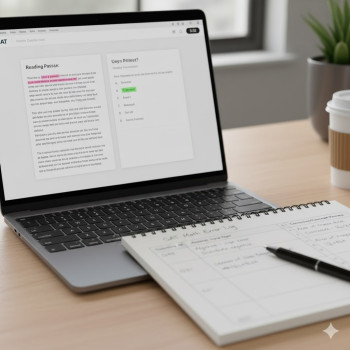Why burnout is the quiet test-day enemy
Picture this: you’ve been grinding for weeks—practice tests, flashcards, late-night reviews of algebra and command of evidence—yet on the morning of your SAT you feel foggy, exhausted, and strangely unmotivated. That’s burnout. It doesn’t care about how many practice tests you’ve taken; it eats away at concentration, memory retrieval, and confidence. And the worst part? Unlike a missed homework assignment, burnout can quietly undermine months of effort.
Burnout during SAT prep shows up in many ways: chronic fatigue, irritability, loss of interest, procrastination, and a creeping sense that test day will never arrive because you’ll never be ‘ready enough.’ The good news is that burnout is preventable and recoverable. With the right strategies, you can prepare hard without wearing yourself down.
Start with a realistic plan (not a punishment)
When students talk about their study plans, they often mean a rigid schedule that leaves no room for life. Replace that image with a plan that treats preparation like a marathon, not a sprint. A sustainable plan helps you improve steadily while protecting your energy and sanity.
Build your baseline
Before you design a schedule, take one full-length Digital SAT practice test under realistic conditions. The result is not a verdict on your future — it’s a starting point. From that baseline you’ll see which sections need the most attention and how your endurance holds up across the test.
Use SMART goals for study sessions
SMART — Specific, Measurable, Achievable, Relevant, Time-bound — is practical and flexible. Instead of “study math,” try “do 20 algebra II practice questions and review explanations in 60 minutes.” Small wins build momentum and reduce dread.
Sample weekly framework
Here’s a balanced template you can adapt based on how many weeks you have until test day.
| Day | Focus | Time | Goal |
|---|---|---|---|
| Mon | Targeted Practice (Weakest Area) | 60–90 min | Skill drills + error log review |
| Tue | Reading/Vocab Practice | 45–60 min | Passage strategy + 2 SAT reading sets |
| Wed | Full Math Section (timed) | 70–90 min | Apply pacing; review mistakes |
| Thu | Essay-style Writing Practice / Grammar | 45–60 min | Focus on clarity, concision, grammar rules |
| Fri | Mixed Practice / Flashcards | 30–45 min | Low-stakes work; reinforce memory |
| Sat | Full Practice Test (every 2–3 weeks) | 3–4 hours | Assess progress and stamina |
| Sun | Rest + Light Review | 30–60 min | Reflection, plan for next week |
This kind of plan keeps work focused and finite. Notice the built-in lighter days and the weekly rest — those are your anti-burnout armor.
Daily habits that defend against burnout
Consistency matters more than intensity. A few daily habits yield outsized returns for energy, focus, and memory.
Sleep like it’s part of your study routine
Memory consolidation happens during sleep. If you skip deep sleep to cram, the material won’t stick. Try to keep a consistent bedtime and wake time, even on weekends. Quality sleep is as much an investment in your SAT score as practice problems.
Move your body
Short bursts of exercise clear mental fog. A 10–20 minute walk, a quick HIIT routine, or stretching between blocks of study improves blood flow, mood, and focus. Use physical breaks as non-negotiable reset points.
Eat like a test-prep pro
Fuel that slow-burns: whole grains, proteins, healthy fats, and hydrating fruits and vegetables. Avoid the sugar crash of heavy sweets before practice tests; your concentration will thank you.
Micro-breaks and the Pomodoro advantage
Study in focused intervals (e.g., 25–45 minutes) with 5–10 minute breaks between them. After 3–4 intervals, take a longer 20–30 minute break. This rhythm keeps energy high and prevents mental fatigue.
Make practice smarter, not longer
Burnout often comes from inefficient study. If you’re putting in long hours without clear feedback, you’ll feel tired and stalled. Instead, make every minute count.
Quality over quantity: active practice beats passive review
- Do problems with intention—predict answers, then check. Ask yourself why each wrong choice is wrong.
- Review explanations fully. Don’t just mark problems ‘done’—teach the concept to yourself or a friend.
- Use the Student Question Bank or official practice materials to mimic the Digital SAT’s style and question types.
Keep an error log
An error log is a simple tracker: question type, why you missed it, and the correction. Over weeks, patterns emerge: maybe pacing, not algebra, is your problem. Fix the root cause, not the symptom.
Simulate test conditions selectively
Full-length tests are essential for stamina and pacing, but they’re expensive in terms of energy and time. Use them every 2–3 weeks instead of weekly unless you have a narrow window before test day.
When to push and when to pause
High-performing students aren’t machines; they know how to adjust. Here’s how to decide whether to power through or step back.
Red flags that you need a true break
- Waking up feeling exhausted despite sufficient sleep.
- Dropping practice scores for a week straight.
- Constant negative self-talk or dread about studying.
- Loss of appetite or inability to concentrate for short sessions.
If you see these signs, take a 24–72 hour reset: no SAT work. Do something that replenishes you—hang out with friends, play sports, or dive into a hobby. You’ll return fresher and often more productive.
Planned tapering before test day
Taper like an athlete. In the final week, reduce heavy practice and prioritize short review sessions: error log scans, pacing drills, and a light timed section. The day before the test, do a brief, confidence-building review and then rest.
Mental strategies that build resilience
Your mindset matters. Burnout is as much emotional as it is physical. Building mental resilience helps you maintain steady effort without emotional drain.
Shift from outcome to process
Instead of obsessing over a target score every study block, celebrate process goals: “I completed three timed sections today” or “I reduced careless errors by 30% this week.” Process goals are controllable and reduce anxiety.
Practice self-compassion
Everyone misses questions. Treat mistakes as data, not evidence that you’re failing. Self-blame fuels burnout; curiosity fuels improvement.
Visualize a confident test day
Spend 5 minutes a day imagining a calm, clear-headed test experience. Visual rehearsal helps reduce fear and primes the brain for calmer problem-solving.
Leverage tools and personalized help
You don’t have to do this alone. Smart tools and targeted support can reduce wasted effort and preserve energy.
Official practice and device familiarity
Practice with the official Bluebook-style digital interfaces when possible. Familiarity with the test environment reduces surprises on test day and lowers stress. Practicing on the same device type you’ll use in the test center is especially helpful.
Targeted tutoring when you’re stuck
Sometimes the shortest route out of burnout is focused help. Personalized tutoring—like Sparkl’s 1-on-1 guidance and tailored study plans—can rapidly identify weaknesses and create efficient, sustainable study routines. An expert tutor can show you how to fix recurring errors without extra hours of trial-and-error practice.
Study tools that protect energy
- Adaptive practice platforms that focus on your weaknesses rather than repeating what you already know.
- Time-tracking apps to keep sessions short and intentional.
- Digital flashcards for spaced repetition—high retention, low time cost.
Social support: don’t study in isolation
Connecting with peers and mentors is energizing. Study groups can be two-way mirrors: explaining a concept to someone else deepens your understanding and boosts confidence. Keep group sessions short and focused: a single topic, a set of problems, and 45–60 minutes max.
How to structure a low-stress study group
- Pick a specific topic (e.g., data interpretation or subject-verb agreement).
- Assign roles: one student times, one leads discussion, one keeps the error log.
- End with two action items each: one to practice and one to teach back next time.

Practical last-week checklist
When the test is less than a week away, follow a compact checklist to preserve energy and confidence.
- Confirm test time, location, and device requirements (Bluebook app installed if required).
- Pack your bag the night before: approved ID, test admission ticket, snacks, water, and a backup charger if allowed.
- Do one short, timed section for pacing—no heavy learning.
- Review your error log and flashcards for 30–60 minutes, then stop.
- Get a good night’s sleep twice in a row before the test.
When burnout lingers: recovery strategies
If burnout has already set in for more than two weeks, a stronger recovery plan is needed. It’s okay to pause formal prep and rebuild your foundation.
Steps to recover
- Take a dedicated rest window: three to seven days of no SAT work.
- Reintroduce light, enjoyable study: short concept videos, flashcards, or a single untimed practice section.
- Re-evaluate goals and timeline—maybe push the test date to let your prep be sustainable.
- Consider 1-on-1 tutoring to jumpstart progress with less wasted effort. Personalized plans (including those offered by Sparkl) can be designed to rebuild momentum without overloading you.
Example: turning a slump into momentum
Emma’s story is familiar. Two months before the test she hit a wall: her practice math score dropped and she started skipping sessions. Instead of doubling down, she did three things:
- Took a four-day rest and then returned to 30-minute targeted sessions.
- Booked three tutoring sessions to address pacing and algebra misconceptions.
- Used a compact weekly plan with two rest activities and one social study session.
Within three weeks Emma’s scores began to climb again. The trick wasn’t more hours—it was smarter work and recovery time.
When to ask for help beyond tutoring
If your fatigue includes anxiety that’s interfering with daily life, or if sleep and appetite are dramatically changed, talk to a counselor, parent, or school advisor. Academic goals matter, but so does your wellbeing. Asking for help is part of a mature performance strategy.

Final thoughts: make preparation sustainable, not sacrificial
Studying for the Digital SAT is a meaningful investment in your future, but it shouldn’t cost your health. Burnout doesn’t mean you’re weak; it means the system you’re using to prepare needs tuning. Treat your prep like professional training: measured plans, recovery days, targeted interventions, and occasional expert guidance.
If you ever feel stalled, consider a short reset, refine your plan using concrete metrics (error logs, timed sections, and restful nights), and reach out for personalized coaching when needed. Sparkl’s personalized tutoring—featuring 1-on-1 guidance, tailored study plans, expert tutors, and AI-driven insights—can be a smart way to accelerate progress while protecting your energy.
With a realistic plan, healthy daily habits, smarter practice, and support when you need it, you can walk into test day rested, focused, and ready to show what you know—without having burned out to get there.
Quick reference: anti-burnout checklist
- Baseline test → create a SMART study plan.
- Use focused intervals + micro-breaks (Pomodoro).
- Prioritize sleep, movement, and nutrition.
- Keep an error log and use targeted practice.
- Schedule full tests sparingly for stamina checks.
- Take real breaks when red flags appear.
- Use 1-on-1 help if stuck; adjust your timeline if needed.
Good luck—and remember: progress is a series of small, recoverable steps. Protect your energy, learn strategically, and the results will follow.

















No Comments
Leave a comment Cancel